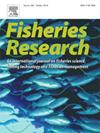Maximizing growth, efficiency, and cost-effectiveness: Evaluating feed strategies for flathead lobsters
IF 2.2
2区 农林科学
Q2 FISHERIES
引用次数: 0
Abstract
The study aimed to identify the most suitable feed for flathead lobsters (Thenus oreintalis) regarding growth performance and cost-effectiveness. Four treatments were evaluated, including sinking pellet (shrimp feed), green mussel, clam, and mackerel, with each treatment replicated three times. Wild flathead lobsters with sizes ranging from 60 to 70 g were randomly assigned to each treatment group, with five lobsters per replication. The lobsters were fed twice daily with different feeds for 90 days in a recirculating closed system. Results showed that flathead lobsters fed with green mussels had the highest growth performance and utilization while having lower feed costs and total costs than other treatments (P < 0.05). The proximate analysis of flesh and exoskeleton revealed that flathead lobsters fed with sinking pellets had the highest protein percentage. In contrast, those fed with green mussels had the highest lipid and chitin percentage. Moreover, protease activity extracted from the hepatopancreases of flathead lobsters fed with green mussels exhibited the highest activity, while the amylase and lipase activity varied among groups. The chitin structure analysis using SEM, FTIR, and FTIR assays revealed that the feed pattern closely matched the optimal growth and feed utilization, including the B/C ratio, for flathead lobsters cultured in a closed system were green mussels.
求助全文
约1分钟内获得全文
求助全文
来源期刊

Fisheries Research
农林科学-渔业
CiteScore
4.50
自引率
16.70%
发文量
294
审稿时长
15 weeks
期刊介绍:
This journal provides an international forum for the publication of papers in the areas of fisheries science, fishing technology, fisheries management and relevant socio-economics. The scope covers fisheries in salt, brackish and freshwater systems, and all aspects of associated ecology, environmental aspects of fisheries, and economics. Both theoretical and practical papers are acceptable, including laboratory and field experimental studies relevant to fisheries. Papers on the conservation of exploitable living resources are welcome. Review and Viewpoint articles are also published. As the specified areas inevitably impinge on and interrelate with each other, the approach of the journal is multidisciplinary, and authors are encouraged to emphasise the relevance of their own work to that of other disciplines. The journal is intended for fisheries scientists, biological oceanographers, gear technologists, economists, managers, administrators, policy makers and legislators.
 求助内容:
求助内容: 应助结果提醒方式:
应助结果提醒方式:


